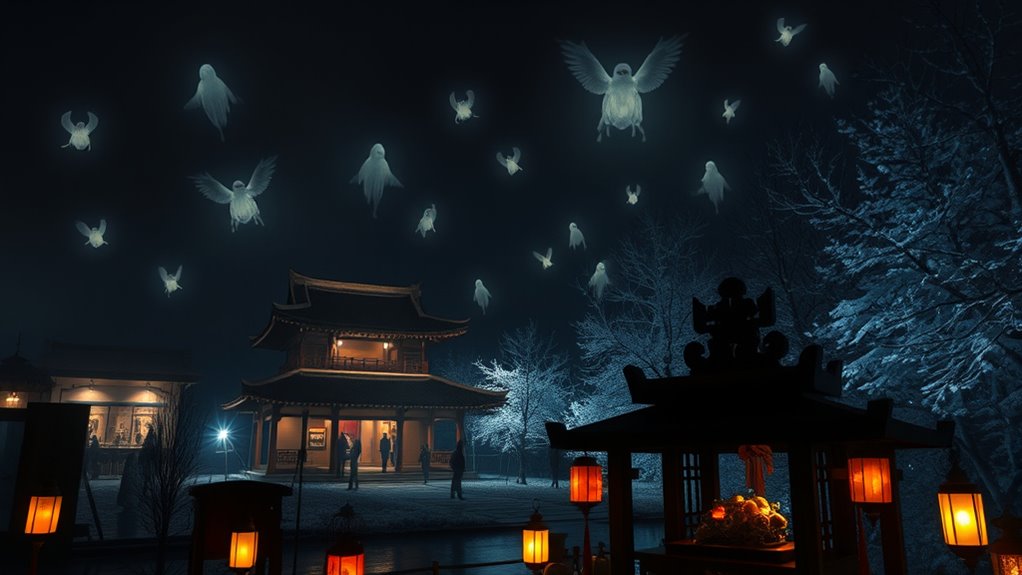Around the globe, different cultures see spirits and ghosts as essential parts of life. In Europe, castles have ghost stories tied to history and legends. In Asia and Africa, ancestors are honored with rituals and offerings. Indigenous North Americans and South Americans believe spirits guide and influence daily life, while Middle Eastern tales warn against unseen spirits with protective charms. Modern practices blend tradition with new beliefs, showing how these unseen forces reflect cultural values. If you keep exploring, you’ll uncover even more fascinating stories behind the unseen.
Key Takeaways
- Cultures worldwide perceive spirits as ancestral guides, protective entities, or haunted remnants of history, shaping rituals and beliefs.
- European societies often see ghosts as former nobles or tragic figures haunting castles, blending folklore with historical events.
- Asian cultures honor ancestors through offerings and prayers, believing spirits influence daily life and ensure family continuity.
- Indigenous communities in North and South America maintain sacred sites and rituals to communicate with and honor ancestral spirits.
- Modern interpretations reframe ghosts as symbols of memory, trauma, or entertainment, with tourism, technology, and media transforming perceptions.
European Haunted Castles and Their Ghostly Legends
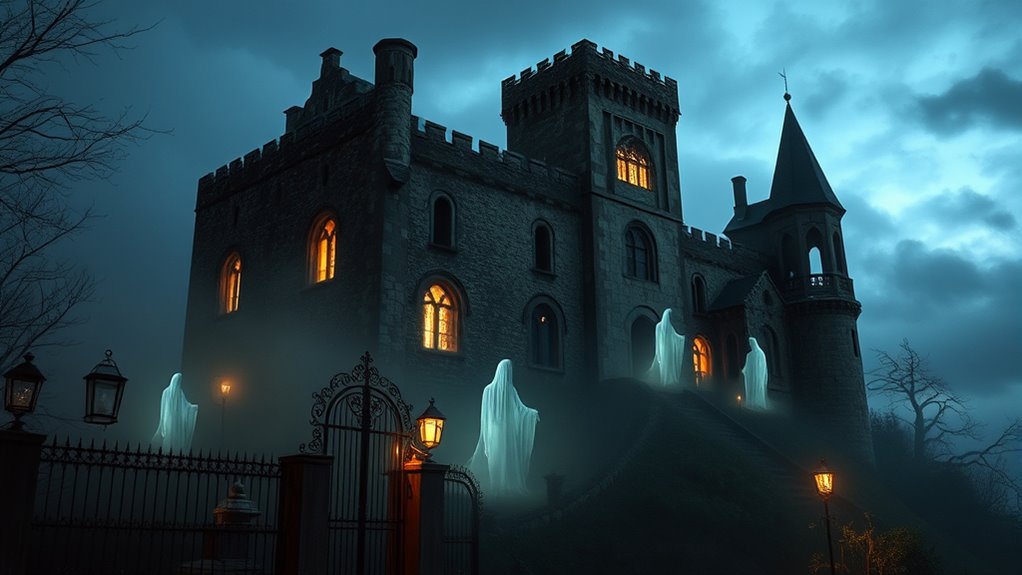
Many European castles are shrouded in ghostly legends that have persisted for centuries. Their medieval architecture, with towering walls and intricate battlements, creates an eerie atmosphere that fuels ghost stories. These castles often hold noble legends of past inhabitants—royalty, knights, and tragic lovers—whose spirits are said to still wander the halls. You might hear tales of apparitions seen at midnight or unexplained sounds echoing through stone corridors. Such stories have been passed down through generations, blending history and superstition. The historical context of these legends often intertwines real events with folklore, enhancing their mystique. Additionally, the cultural significance of these stories varies across regions, contributing to their enduring popularity. Interestingly, story preservation practices, including oral tradition and modern documentation, play a crucial role in maintaining these legends over time. Modern technologies, such as audio and video recordings, are increasingly used to document ghost sightings, helping to keep the legends alive for new audiences. Whether it’s the restless spirit of a betrayed noble or a phantom knight guarding hidden treasure, these legends add a haunting allure to the castles’ centuries-old walls. Exploring them, you sense history alive with spectral whispers of bygone eras. Cybersecurity principles can even be applied to protect the authenticity of such ghost stories, ensuring their preservation against falsehoods.
Asian Spirit Worlds: Ancestors and Reverence

In Asian cultures, reverence for ancestors plays a central role in spiritual life, guiding daily practices and communal traditions. You actively participate in ancestor veneration by remembering loved ones through offerings and prayers. Ritual offerings, such as food, incense, and symbolic items, are presented at family altars or during special festivals like the Lunar New Year or Obon. These practices express respect and maintain a spiritual connection with those who came before you. Many believe that honoring ancestors helps ensure their spirits are at peace and that their blessings continue to influence the living. Respect for ancestors fosters a sense of continuity and community, bridging the gap between the unseen spirits and everyday life. This reverence underscores the importance of honoring the past in Asian spiritual traditions. Incorporating traditional offerings and rituals into daily life helps reinforce this spiritual bond and keeps ancestral reverence alive across generations. Recognizing the significance of cybersecurity vulnerabilities during disruptions highlights the need to protect these cultural practices from modern digital threats. Understanding how cultural preservation can be vulnerable in the digital age emphasizes the importance of safeguarding traditional practices from digital interference.
African Ancestral Spirits and Rituals of Communication
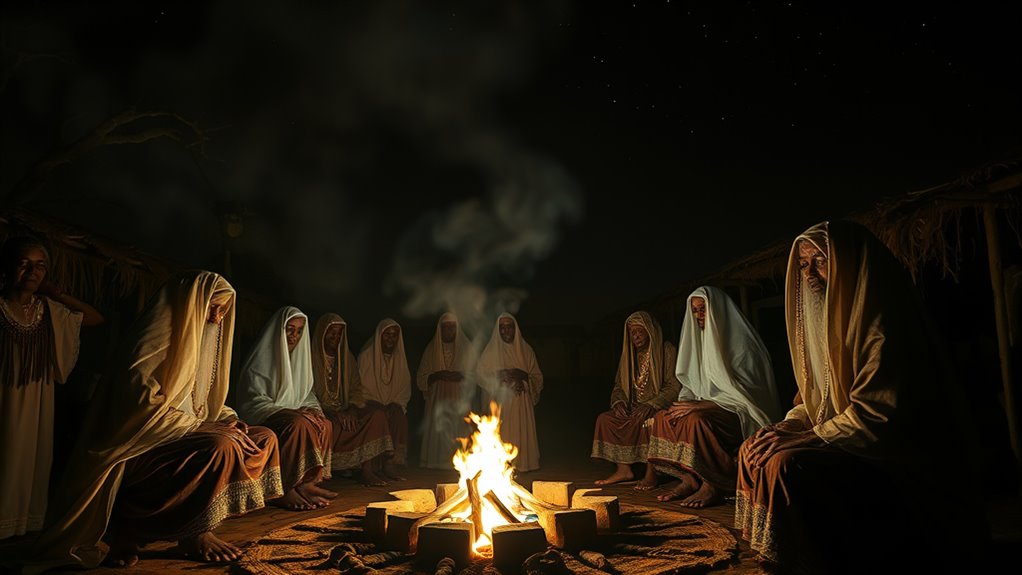
African cultures honor their ancestors through daily veneration practices and special rituals that keep spirits close. You’ll find that communication with ancestors often involves offerings and ceremonies designed to invite guidance or blessings. These rituals highlight the deep respect and ongoing connection they maintain with their ancestral spirits. Incorporating spiritual practices such as offerings and prayers can strengthen the bond between the living and the deceased, ensuring continued protection and guidance. Engaging in these traditional rituals fosters a sense of community and continuity across generations. Additionally, many communities believe that ancestral communication can bring wisdom and help resolve conflicts within the family or tribe. The preservation of ancestral knowledge through storytelling and ceremony is essential for maintaining cultural identity and spiritual harmony.
Ancestral Veneration Practices
You can find vibrant rituals across Africa that honor ancestral spirits, believing these spirits influence daily life and well-being. Ancestor worship plays a central role in many communities, where people regularly perform ritual offerings to show respect and seek guidance. These offerings often include food, drinks, or symbolic objects placed at shrines or sacred sites. Through these acts, you connect with your ancestors, maintaining a spiritual bond that reinforces community values and cultural identity. Ritual offerings serve as a tangible expression of gratitude and remembrance, ensuring ancestors stay honored and involved in the living world. Additionally, the nutritional benefits of chia seeds, such as their capacity to support gut microbiota and promote digestive health, mirror the way these rituals sustain the well-being of the community by nurturing both spiritual and physical health. These practices highlight the deep reverence for ancestors, emphasizing their ongoing presence and influence in shaping the present and future.
Rituals of Spirit Communication
Throughout many African communities, communication with ancestral spirits extends beyond offerings, involving elaborate rituals designed to establish direct contact. You might witness mediumship practices, where practitioners act as conduits for spirits, or engage in spirit photography to capture unseen presences. These rituals often use drumming, dance, and trance states to summon spirits or facilitate messages. Spirit communication is deeply personal, relying on specific techniques that vary by region. Understanding the cultural significance of these practices highlights their importance within community traditions. Incorporating mindfulness techniques can deepen practitioners’ awareness and connection during these spiritual ceremonies.
Significance of Ancestor Offerings
Ancestor offerings hold profound significance in African spiritual practices, serving as essential bridges between the living and the departed. Through these offerings, you demonstrate ancestral reverence, honoring those who came before you. The offering significance lies in maintaining harmony and ensuring their guidance continues. Rituals often include food, drinks, or symbolic items, which are presented to invite communication and blessings from ancestors. By performing these acts regularly, you reinforce your connection with your lineage and affirm your respect for tradition. These offerings are not just gestures of remembrance but active ways to seek wisdom, protection, and support from those who have passed. Ultimately, ancestor offerings deepen your spiritual bond, emphasizing the importance of honoring the past to nurture your present and future.
Indigenous North American Ghost Beliefs and Cultural Practices
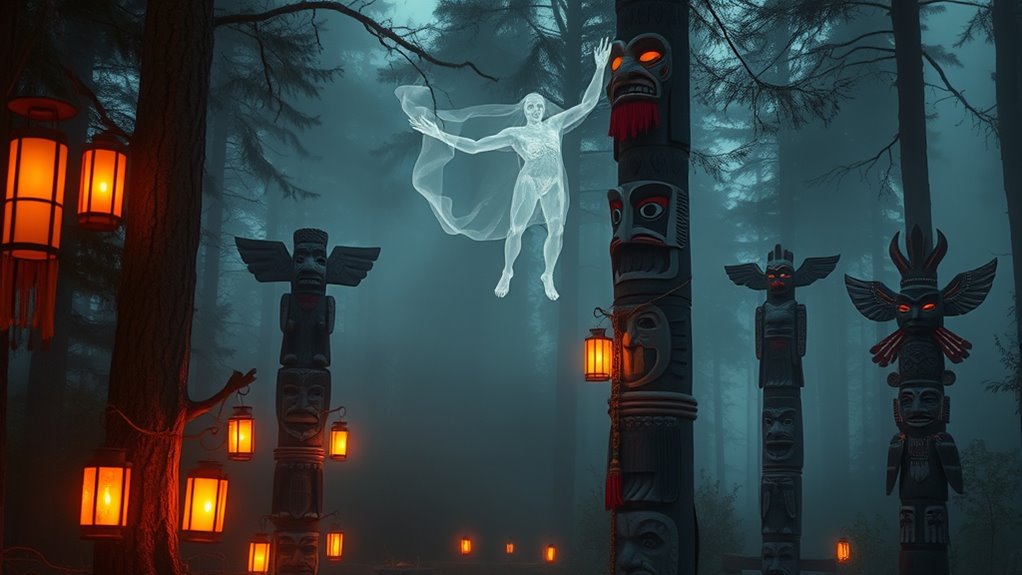
You can see how Indigenous North American communities maintain strong connections with ancestral spirits through specific rituals and offerings. Sacred sites often serve as places where ghosts are honored and communicated with, reinforcing cultural traditions. These practices highlight the deep respect and ongoing relationship between the living and the spirits of the past.
Ancestral Spirit Connections
Many Indigenous North American communities believe that spirits of their ancestors remain present in daily life, guiding and protecting their descendants. They see ancestor communication as a essential part of maintaining their spiritual lineage, ensuring their ancestors’ wisdom continues to influence their community. These spirits are not distant; they are active in guiding decisions, offering protection, and providing insight. Rituals, ceremonies, and storytelling serve as ways to honor and stay connected to these spirits. By maintaining this bond, they preserve cultural values and strengthen their identity. The belief in ongoing relationships with ancestors underscores a profound respect for lineage, emphasizing that the spirits of those who came before are always present, watching over and supporting their descendants in everyday life.
Rituals and Offerings
Rituals and offerings serve as essential ways for Indigenous North American communities to honor and communicate with spirits of the deceased. Through ancestor offerings, you show respect and maintain a spiritual connection with those who came before you. These offerings often include food, crafted objects, or symbolic items that hold ritual symbolism, representing the ongoing relationship between the living and the dead. You might perform ceremonies at specific times or during cultural events, using prayer and ritual gestures to invite spirits’ presence. The act of giving and the rituals involved reinforce cultural values and spiritual beliefs, ensuring that ancestors remain honored and remembered. These practices help keep the spirits close, guiding and protecting your community through meaningful, tradition-based expressions of reverence.
Sacred Sites and Ghosts
Have you ever wondered how sacred sites influence indigenous beliefs about spirits and ghosts? For many indigenous North American communities, these sites are considered gateways to the spirit world. They often incorporate meditation practices to communicate with ancestors and spirits, believing these locations hold sacred energy. Ghost stories linked to haunted house architecture aren’t just tales; they reflect spiritual reverence for specific places. Structures built with spiritual significance often feature design elements that honor the unseen world, creating spaces where the boundary between the living and the dead feels thin. These sacred sites serve as centers for rituals, storytelling, and spiritual ceremonies that reinforce community bonds and respect for ancestors. Through these practices, indigenous cultures maintain a profound connection with spirits and the unseen domain.
South American Folklore and the Spirit Realm
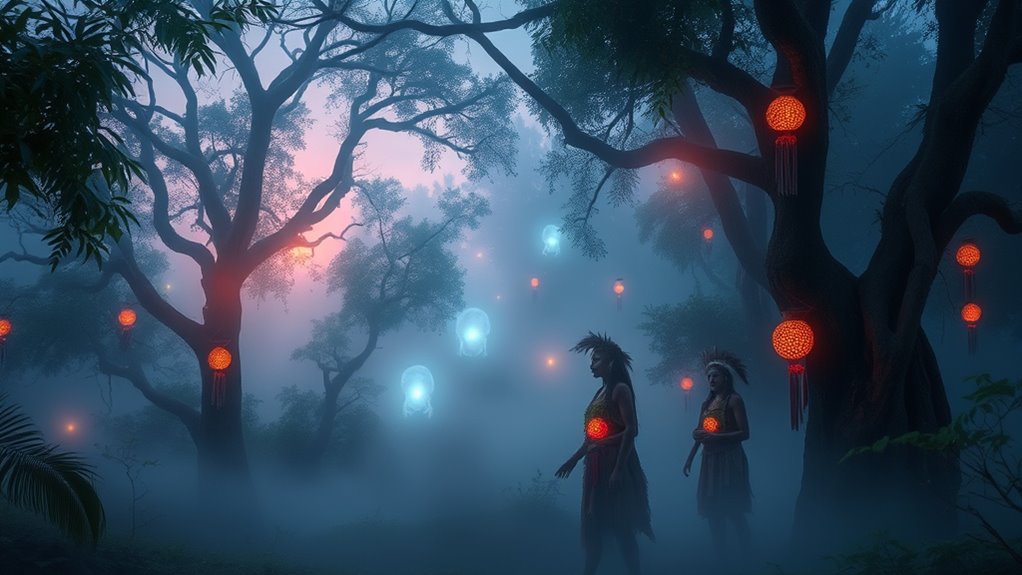
South American folklore is rich with stories of spirits and supernatural beings that shape the cultural landscape of the region. You’ll find beliefs in spirit possession, where spirits temporarily inhabit humans, influencing their behavior. Supernatural festivals are common, honoring spirits and seeking protection or guidance. These events often feature dances, rituals, and offerings to communicate with the unseen domain. The folklore emphasizes a close connection between the living and spirits, shaping daily life and community traditions. Below is a visual guide to some key ideas:
| Spirit Type | Rituals & Festivals | Cultural Significance |
|---|---|---|
| Ancestor Spirits | Día de los Muertos | Honoring family and heritage |
| Nature Spirits | Inti Raymi | Celebrating natural forces |
| Guardian Spirits | Festival of the Sun | Protection and prosperity |
| Trickster Beings | Carnaval and local legends | Teaching morals and lessons |
| Evil Spirits | Rituals for protection | Ward off negative influences |
Australian Aboriginal Dreamtime and Spiritual Encounters

The Australian Aboriginal Dreamtime is a foundational spiritual concept that describes how the world was created and how ancestral beings continue to influence daily life. You might hear stories passed down through Dreamtime stories, which explain the origins of land, animals, and humans. These stories serve as a guide for moral values and cultural identity. Spiritual encounters often occur during ceremonies or sacred sites, where elders believe they connect with ancestral spirits. These encounters aren’t about ghosts in the traditional sense but are seen as ongoing relationships with spiritual beings that shape the environment and community. By understanding the Dreamtime, you gain insight into a worldview where the spiritual and physical worlds are intertwined, guiding everyday life and cultural continuity.
Middle Eastern Ghost Stories and Protective Talismanic Traditions
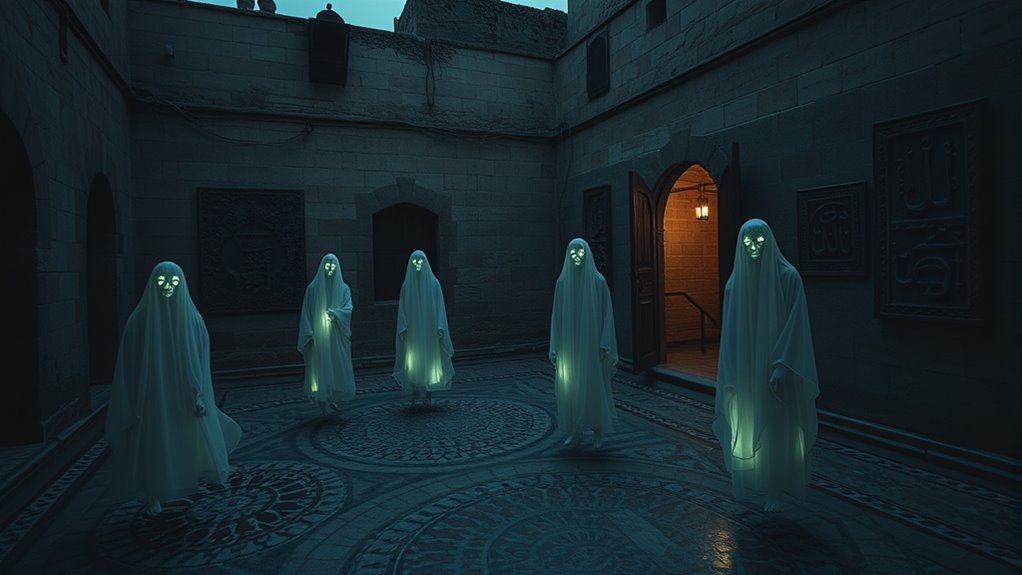
In Middle Eastern cultures, stories of spirits and ghosts often serve as cautionary tales or explanations for unexplained events, reflecting a deep belief in unseen forces. These tales are rooted in regional ghost legends that warn against malevolent spirits and encourage protective measures. You might hear about:
- The jinn, spirits that can influence or haunt people if not properly warded off.
- The use of amulets and talismanic protection, believed to keep harmful spirits at bay.
- Rituals and prayers performed to appease restless ghosts or invoke divine protection.
These traditions highlight how Middle Eastern societies blend storytelling with practical protection strategies. Talismanic protection remains central, reinforcing cultural values and spiritual resilience against unseen threats.
Caribbean Spirits: Voodoo, Santería, and Cultural Syncretism

Caribbean spirits like those found in Voodoo and Santería play a pivotal role in shaping local beliefs and practices, blending African, Indigenous, and European traditions into a rich tapestry of spiritual symbolism. Haitian Vodou, for example, connects practitioners with lwa, spirits that influence daily life, while Santería Rituals honor Orishas through music, dance, and offerings. You might participate in ceremonies where spirits are invoked to seek guidance or protection, demonstrating the deep cultural significance of these practices. These spiritual systems emphasize harmony with unseen forces, blending African deities with Catholic saints, reflecting a history of cultural resilience and adaptation. By understanding these traditions, you gain insight into how spirits are woven into the social and spiritual fabric of Caribbean life.
Eastern European Folklore and the Ties to the Afterlife
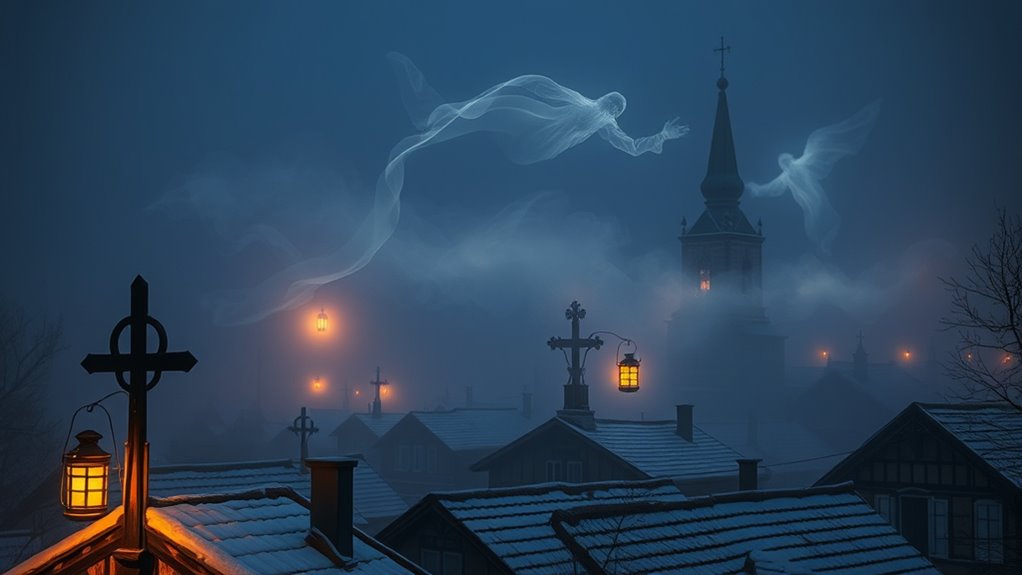
Across Eastern Europe, folklore abounds with stories of spirits and the afterlife that reflect a deep connection to the unseen world. You’ll find that medieval rituals and folklore legends shape many beliefs about ghosts and the dead. For example, 1) Protective rituals like lighting candles to guide spirits, 2) Legends of restless souls wandering, and 3) The belief that certain sites, like cemeteries, are gateways to the afterlife. These stories often emphasize honoring ancestors and performing specific rites to ensure peace for the dead. You might hear of rituals to summon or banish spirits, rooted in ancient traditions passed down through generations. These tales reveal a culture that views the afterlife as intertwined with everyday life, with ghosts serving as reminders of the spiritual domain’s importance.
The Modern Reinterpretation of Ghosts Across Cultures
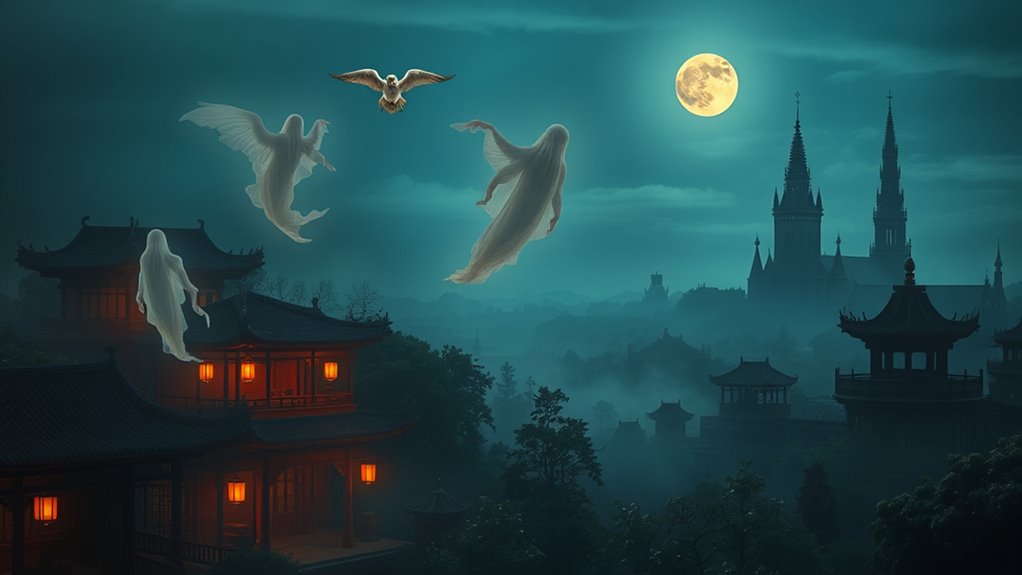
As societies evolve, so do their interpretations of ghosts, shifting from traditional spirits to modern symbols of memory, trauma, or entertainment. Today, you might experience modern ghost tourism, visiting haunted sites that blend history with thrill-seeking adventures. This trend reflects how ghosts are now seen less as supernatural entities and more as cultural artifacts or stories. Digital hauntings also play a role, with ghostly apparitions appearing in online videos or virtual reality experiences, blurring the lines between the real and the virtual. These reinterpretations make ghosts more accessible, serving as tools for reflection, entertainment, or social commentary. Across cultures, the idea of spirits adapts to contemporary contexts, transforming ancient beliefs into modern phenomena that resonate with today’s digital and experiential worlds.
Frequently Asked Questions
How Do Different Cultures Interpret the Presence of Ghosts During Significant Life Events?
You might notice that cultures interpret ghosts during significant life events through ancestor reverence and ritual symbolism. For example, some see spirits as guides or protectors, honoring them with offerings and ceremonies. Others view ghosts as reminders of family ties and history, emphasizing respect and remembrance. These beliefs shape rituals, blending reverence and symbolism, so you can understand how different societies honor their ancestors and acknowledge the unseen presence during pivotal moments.
What Role Do Ghost Stories Play in Preserving Cultural Identity Worldwide?
You see, ghost stories serve to preserve cultural identity by fostering ancestral reverence, reinforcing mythological narratives, and passing traditions down through generations. They connect you to your history, shape your values, and define your community’s worldview. Through storytelling, you honor the past, celebrate shared beliefs, and keep your cultural legacy alive. These tales become an essential part of your identity, uniting you with others who cherish the same spiritual and cultural roots.
Are There Common Symbols or Signs Associated With Spirits Across Diverse Cultures?
You’ll notice that many cultures share common spirit symbols and cultural signs, like lanterns, which symbolize guidance or spirits, or white clothing representing purity or mourning. These symbols often serve as universal signs of the unseen, helping you recognize spirit presence or communication. While specific symbols vary, the underlying themes of protection, remembrance, and connection bridge diverse cultural perspectives on spirits worldwide.
How Do Cultural Beliefs About Ghosts Influence Modern Paranormal Research Methods?
You see, cultural beliefs about ghosts shape modern paranormal research by guiding how investigators approach phenomena. You might find that cultural rituals and spiritual symbolism influence the methods used, such as specific prayers or artifacts believed to attract or banish spirits. These traditions help researchers interpret evidence, making their investigations more culturally sensitive and meaningful, ultimately blending scientific inquiry with spiritual understanding.
In What Ways Do Cultural Taboos Shape the Way Societies Perceive and Interact With Spirits?
Did you know that in some societies, over 60% of people avoid discussing spirits due to strong taboos? These taboos enforce spiritual boundaries, shaping how societies perceive and interact with spirits. You might find that taboo enforcement discourages open conversations, leading to secretive rituals or avoidance. Such cultural restrictions influence people’s beliefs, often making interactions with spirits seem sacred or forbidden, consequently deeply embedding spiritual boundaries into daily life.
Conclusion
As you explore these diverse beliefs, you realize that ghosts are the threads weaving humanity’s shared tapestry of the unseen. Each culture’s stories, rituals, and legends serve as bridges between worlds, whispering that the spirit domain is always just beyond the veil. Like a universal language of the soul, these ghostly tales remind you that in every corner of the globe, the unseen is an eternal dance of remembrance and reverence.
